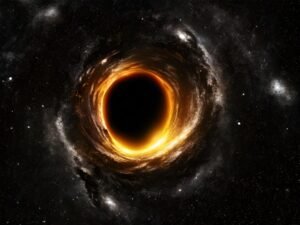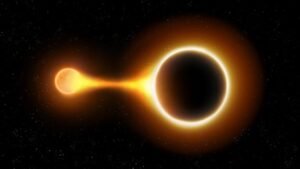Scientists Say Miniature Black Holes Might Be in Your Home—Here’s What That Means!
What if the answers to some of the universe’s biggest mysteries were not in space but right here on Earth? It might sound like science fiction, but scientists think tiny, ancient black holes—called Primordial Black Holes (PBHs)—could be closer than we realize. They might even pass through objects around us every day.
These tiny black holes are different from the massive ones created by collapsing stars. They are incredibly hard to find but might explain dark matter, a mysterious substance that makes up most of the universe’s mass. Some scientists believe these black holes could leave microscopic traces in materials on Earth—maybe even in the walls of your house. Could these tiny black holes be traveling through our world unnoticed? And if they are, what could they teach us about the universe?

Primordial Black Holes (PBHs) are theoretical black holes thought to have formed just after the Big Bang. Unlike black holes formed when stars collapse, PBHs might have come from tiny, dense regions in the early universe. These regions were so compact they collapsed into black holes, which could range in size from a small fraction of a gram to thousands of times the mass of the sun.
The idea of PBHs was first proposed over 50 years ago and has been studied ever since. Because they are not made of normal matter, scientists think PBHs could be the mysterious dark matter that makes up 85% of the universe’s mass.
PBHs could help us learn more about the early universe and high-energy physics. Since they formed during the universe’s birth, studying them might reveal clues about that time. PBHs might also help us explore strange phenomena, like extra dimensions or quantum gravity.
Despite their importance, scientists have not found direct evidence of PBHs yet. Many would have evaporated over time due to a process called Hawking radiation, but the ones that were heavier could still exist today. Scientists are continuing their search for these fascinating objects.

Although PBHs are tiny, they have strong gravitational forces that allow them to interact with their surroundings in unique ways. Recent studies suggest that PBHs could pass through solid materials, leaving microscopic tunnels behind.
For example, a PBH with a mass of about 10²² grams would create a tunnel around 0.1 microns wide. This is too small to see with the naked eye but could be detected using advanced microscopes. Physicist Dejan Stojkovic explains, “A fast-moving primordial black hole passing through solid matter would leave behind a very straight, extremely narrow tunnel.”
On a larger scale, PBHs could affect planets or moons. If a PBH passed through an object with a liquid core, it could become temporarily trapped, slowly absorbing the core’s material. This could hollow out the inside of the planet or moon, leaving just a shell. Stojkovic explains, “If the core is liquid, a PBH can absorb it, as its density is higher than the solid outer layer.”
Although it’s unlikely a PBH would pass through Earth, scientists have suggested looking for these microscopic tunnels in old materials. Ancient rocks or structures could hold evidence of PBHs passing through them. Stojkovic says that checking for these traces could be much cheaper than building special detectors for PBHs.

Finding PBHs is difficult, so scientists use indirect methods to search for evidence. They’ve come up with creative ways to study both cosmic and earthly clues.
Microlensing Observations
Microlensing occurs when a massive object, like a PBH, bends the light from a distant star as it passes in front of it. This technique can reveal hidden objects. Some studies suggest that PBHs with masses similar to the sun’s could make up part of the dark matter in galaxies.
Gravitational Waves
Scientists have detected gravitational waves from black hole mergers using observatories like LIGO and Virgo. Some of these black holes have masses that don’t fit the usual models of how black holes form. This has led researchers to think PBHs might be responsible.
Microscopic Tunnels on Earth
Another idea is to search for tiny tunnels in materials on Earth that PBHs might have passed through. Stojkovic believes this approach could be cost-effective and provide valuable evidence of PBHs: “Looking for microscopic tunnels in old materials could cost much less than building special detectors.”
Primordial Black Holes (PBHs) could help solve some of the biggest mysteries about the universe, like the nature of dark matter and how galaxies formed.
PBHs as Dark Matter
Dark matter makes up most of the universe’s mass, but scientists still don’t know what it is. Since PBHs are not made of regular matter and are very stable, they are good candidates for dark matter.
Seeding Supermassive Black Holes
Supermassive black holes at the centers of galaxies, including our own Milky Way, are a mystery because they seem to have formed very quickly. PBHs could act as “seeds” for these giant black holes, helping them grow. Observations from the James Webb Space Telescope suggest that supermassive black holes existed earlier than we thought, which supports this idea.
Insights into the Early Universe
PBHs could also reveal information about the early universe. Studying them might help scientists understand processes that occurred right after the Big Bang. PBHs could even give clues about physics beyond the Standard Model, which is the current framework for understanding particles and forces.
Primordial Black Holes, tiny remnants from the universe’s beginning, might hold the answers to some of its deepest questions. From explaining dark matter to reshaping planets, these mysterious objects could change how we understand the cosmos.
Though we haven’t found direct evidence yet, scientists continue to look for PBHs through microscopic tunnels on Earth and cosmic events like gravitational waves. Each clue brings us closer to uncovering their secrets. As physicist Dejan Stojkovic says, “The hardest thing to see is often what’s right in front of you.”
Studying PBHs doesn’t just teach us about the past—it also inspires future generations to push the boundaries of science. In a universe full of mysteries, PBHs show us that even the smallest things can have the biggest impact.
